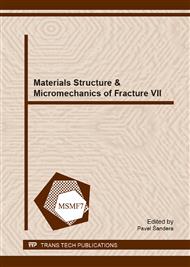p.777
p.781
p.785
p.789
p.793
p.797
p.801
p.805
p.809
Experimental Investigation of Modes II and III Fatigue Crack Growth in Unalloyed Titanium
Abstract:
The study is focused on finding and describing microscopic paths of modes II and III cracks in commercially pure α-titanium (hcp structure). Experiments were done on cylindrical bars with a circumferential cracked notch loaded in shear (modes II, III and II + III) and torsion (mode III). Fractography analysis showed that the crack growth was crystallography-controlled and the deflection and twisting angles of crack propagation direction (with respect to the shear plane) were relatively high. This behavior is a mixture of previously observed morphology in ARMCO iron (bcc) and austenitic steel (fcc). It can be understood in terms of a number of available slip systems in bcc, fcc and hcp lattices.
Info:
Periodical:
Pages:
797-800
Citation:
Online since:
November 2013
Authors:
Keywords:
Price:
Сopyright:
© 2014 Trans Tech Publications Ltd. All Rights Reserved
Share:
Citation:


